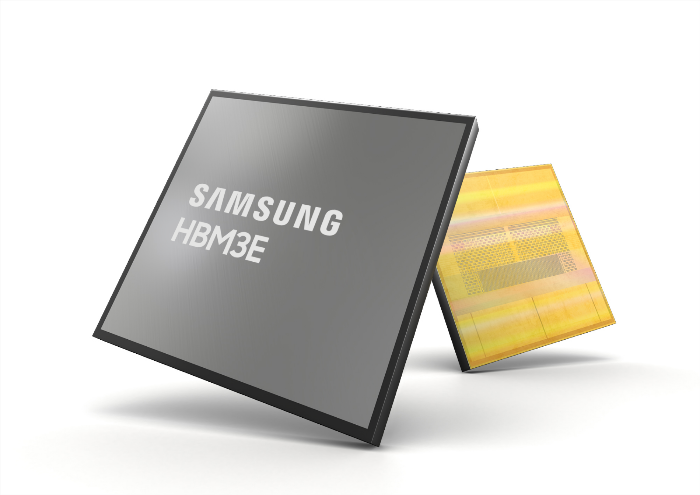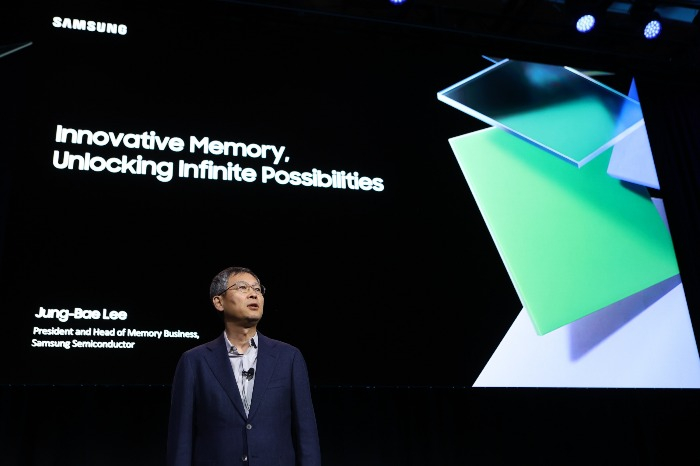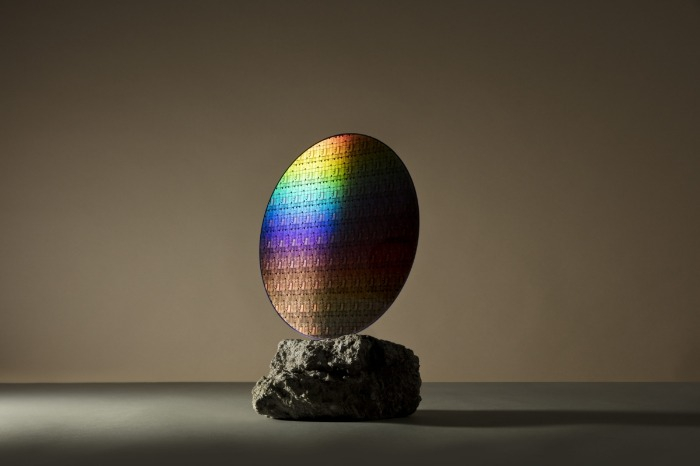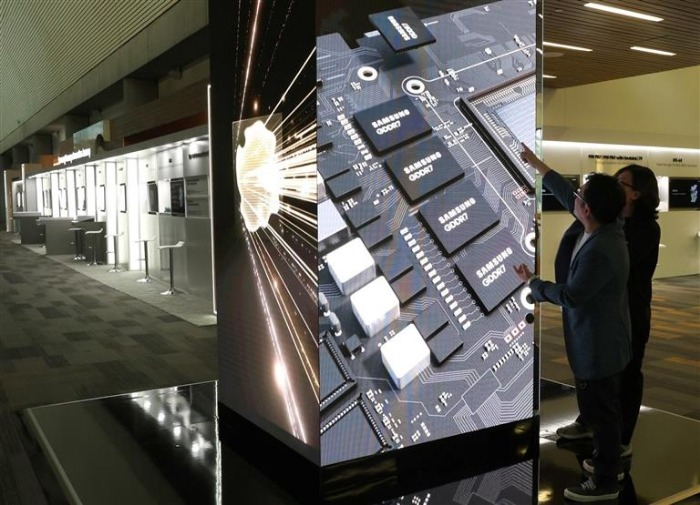Samsung showcases HBM3E DRAM, automotive chips
By 2025, it aims to develop HBM4 and autonomous driving chips to outsmart SK Hynix in the high-capacity AI chip war
By Oct 21, 2023 (Gmt+09:00)
LG Chem to sell water filter business to Glenwood PE for $692 million


KT&G eyes overseas M&A after rejecting activist fund's offer


Kyobo Life poised to buy Japan’s SBI Group-owned savings bank


StockX in merger talks with Naver’s online reseller Kream


Meritz backs half of ex-manager’s $210 mn hedge fund



SILICON VALLEY -- Samsung Electronics Co. on Friday showcased a number of new-concept, next-generation DRAM chips, including the industry’s most advanced HBM3E, alleviating market concerns that it might trail local rival SK Hynix Inc. in the super-giant AI chip market.
At Samsung Memory Tech Day in Silicon Valley, the world’s No. 1 memory chipmaker unveiled its high bandwidth memory 3E (HBM3E), dubbed "Shinebolt."
It features a 1.5 times higher capacity than the existing HBM3 DRAM with about 50% faster processing speed and 10% higher power efficiency.
Samsung has sent its samples to clients such as Nvidia Corp. and AMD.
The announcement comes two months after SK Hynix said in August it has developed HBM3E and provided its samples to Nvidia for performance evaluation. It plans to mass-produce the latest DRAM chip in the first half of next year to lead the AI memory market.

HBM3E is the extended version of HBM3 and the fifth-generation DRAM memory after HBM, HBM2, HBM2E and HBM3.
It can process up to 1.2 terabytes (TB), or 1,200 gigabytes, of data per second.
In August of this year, Samsung sampled the fourth-generation memory, HBM3, for quality verification to the US graphic processing unit designer Nvidia.
By 2025, Samsung aims to develop the sixth-generation DRAM, or HBM4.
The chipmaker is also preparing to offer customized turnkey services that combine foundry and packaging.

AUTOMOTIVE CHIPS
Samsung also showcased a detachable solid-state drive (SSD) and a GDDR7 with a high bandwidth used in vehicles, saying it is aiming to achieve the top spot in the automotive memory chip market by 2025.
The SSD, to be embedded in vehicles, boasts 4TB capacity and continuous read speeds of up to 6,500 megabytes per second (MB/s). Last month, it released a 4TB SSD suitable for gaming devices.
It is the first time that Samsung revealed its ambition for automotive chips, which it expects to be a mid to long-term growth engine.
As autonomous driving systems become more sophisticated, Samsung bets that demand will grow rapidly for high-speed, high-capacity DRAM and data storage devices such as SSDs that can share data with multiple system semiconductors.

11-NANOMETER DRAM
Following the mass production of 12-nanometer DRAM in May of this year, Samsung said on Friday it is developing 11 nm memory chips.
Currently, the 12 nm fabrication process is the industry’s most advanced technology.
It is also preparing to introduce three-dimensional stacking structures for 10 nm chips or below to allow a single chip to process more than 100 gigabits of data.
32 GIGABIT DDR5
During the event, Samsung showcased other types of high-performance, high-capacity and low-power memory chips, including a 32 gigabit DDR5, the industry's highest-capacity memory.

DRAM FOR PERSONAL COMPUTERS, LAPTOPS
It consumes less power and reduces the volume of the applied product, allowing for more efficient use of internal space.
“The CAMM2 will change the landscape of the next-generation PC and laptop DRAM market,” said a Samsung Electronics official.
Write to Jin-Suk Choi and Jeong-Soo Hwang at iskra@hankyung.com
Yeonhee Kim edited this article.
-
 Korean chipmakersSamsung eyes next-generation 5 nm eMRAM auto chip by 2027
Korean chipmakersSamsung eyes next-generation 5 nm eMRAM auto chip by 2027Oct 19, 2023 (Gmt+09:00)
3 Min read -
 Korean chipmakersSamsung vows to up memory chip density to 'extreme levels'
Korean chipmakersSamsung vows to up memory chip density to 'extreme levels'Oct 17, 2023 (Gmt+09:00)
3 Min read -
 EarningsSamsung Electronics’ narrowed Q3 chip losses fuel more bullish outlook
EarningsSamsung Electronics’ narrowed Q3 chip losses fuel more bullish outlookOct 11, 2023 (Gmt+09:00)
3 Min read -
 Korean chipmakersSamsung Elec to launch HBM4 in 2025 to win war in AI sector
Korean chipmakersSamsung Elec to launch HBM4 in 2025 to win war in AI sectorOct 10, 2023 (Gmt+09:00)
2 Min read -
 Korean chipmakersSamsung set to supply HBM3 to Nvidia, develops 32 Gb DDR5 chip
Korean chipmakersSamsung set to supply HBM3 to Nvidia, develops 32 Gb DDR5 chipSep 01, 2023 (Gmt+09:00)
4 Min read -
 Korean chipmakersSK Hynix provides samples of best-performing HBM3E chip to Nvidia
Korean chipmakersSK Hynix provides samples of best-performing HBM3E chip to NvidiaAug 21, 2023 (Gmt+09:00)
3 Min read -
 Korean chipmakersSamsung Elec to provide HBM3, packaging service to Nvidia
Korean chipmakersSamsung Elec to provide HBM3, packaging service to NvidiaAug 01, 2023 (Gmt+09:00)
5 Min read


